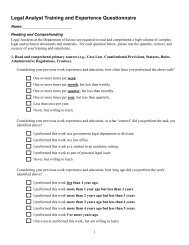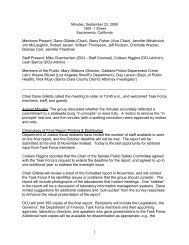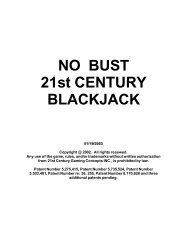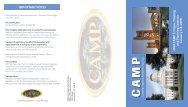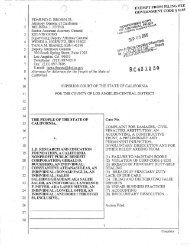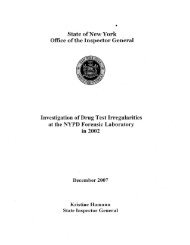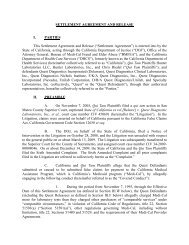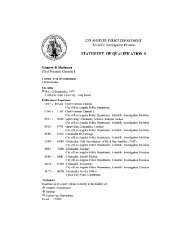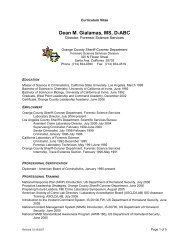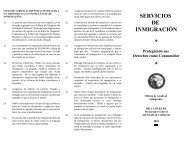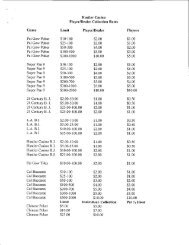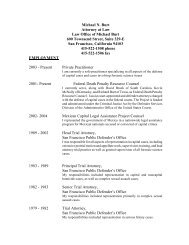Certification of Criminalists
Certification of Criminalists
Certification of Criminalists
You also want an ePaper? Increase the reach of your titles
YUMPU automatically turns print PDFs into web optimized ePapers that Google loves.
CERTIFICATION<br />
OF<br />
CRIMINALISTS<br />
AB 1079 Crime Laboratory Task Force – May 6, 2009<br />
Jennifer Mihalovich and Greg Matheson
<strong>Certification</strong><br />
<strong>Certification</strong> is the process by which individual<br />
practitioners <strong>of</strong> a pr<strong>of</strong>ession are deemed competent<br />
by a peer review process to practice that<br />
pr<strong>of</strong>ession.
Licensure<br />
The granting <strong>of</strong> a license, which gives a 'permission<br />
to practice.' Such licenses are usually issued in order<br />
to regulate some activity that is deemed to be<br />
dangerous or a threat to the person or the public or<br />
which involves a high level <strong>of</strong> specialized skill. The<br />
danger and skill elements inspire governments not<br />
to allow a free-for-all, but to regulate the activity,<br />
and licensing is a well-established and convenient<br />
method <strong>of</strong> regulation.
In the case <strong>of</strong> certain occupations and pr<strong>of</strong>essions, licensing<br />
is <strong>of</strong>ten granted through a pr<strong>of</strong>essional body or a licensing<br />
board composed <strong>of</strong> advanced practitioners who oversee the<br />
applications for licenses. This <strong>of</strong>ten involves accredited<br />
training and examinations.<br />
Many privileges and pr<strong>of</strong>essions require a license, generally<br />
from the state government, in order to ensure that the public<br />
will not be harmed by the incompetence <strong>of</strong> the practitioners.<br />
Engineering, medical practitioners, nurses, lawyers,<br />
psychologists, and public accountants are some examples <strong>of</strong><br />
pr<strong>of</strong>essions that require licensure. Licensure is similar to<br />
pr<strong>of</strong>essional certification, and sometimes synonymous;<br />
however, certification is an employment qualification and<br />
may not a legal requirement for practicing a pr<strong>of</strong>ession.
History <strong>of</strong> <strong>Certification</strong> / Licensure<br />
Doctors, lawyers, teachers, architects, accountants,<br />
engineers, and others are required to demonstrate<br />
a level <strong>of</strong> competence that has been established by<br />
their peers to be the minimum qualifications<br />
necessary to be able to provide their pr<strong>of</strong>essional<br />
services to the public.<br />
The remaining discussion will use the term certification. It is<br />
recognized that certain pr<strong>of</strong>essions require a license versus<br />
certification.
History <strong>of</strong> <strong>Certification</strong> - Medical<br />
American Board <strong>of</strong> Medical Specialties Board<br />
<strong>Certification</strong> for medical doctors was established<br />
On June 11, 1933, a handful <strong>of</strong> physicians met to<br />
talk about the education and certification <strong>of</strong><br />
medical specialists.<br />
The Advisory Board for Medical Specialties created<br />
the framework for standards <strong>of</strong> excellence in the<br />
various specialties that physicians pursue and the<br />
public relies upon.
History <strong>of</strong> <strong>Certification</strong> - Legal<br />
The first State Board <strong>of</strong> Law Examiners in California<br />
was established in 1919 by order <strong>of</strong> the California<br />
Supreme Court.<br />
The name was changed in 1927 when The State Bar<br />
<strong>of</strong> California was <strong>of</strong>ficially established<br />
Committee <strong>of</strong> Bar Examiners is responsible for<br />
administering the requirements for admission to practice<br />
law in California.
History <strong>of</strong> <strong>Certification</strong> – CPA<br />
Certified Public Accountant<br />
Self-regulation by the accounting pr<strong>of</strong>ession can be<br />
traced to just after the Securities and Exchange<br />
Commission was established by the Securities Act <strong>of</strong><br />
1933 and the Securities Exchange Act <strong>of</strong> 1934.<br />
The SEC was given statutory authority to set<br />
accounting standards and oversight over the<br />
activities <strong>of</strong> auditors.<br />
The role <strong>of</strong> establishing auditing standards was left<br />
to the accounting pr<strong>of</strong>ession.
History <strong>of</strong> <strong>Certification</strong> - Architects<br />
The California Architects Board was created in<br />
1901 by the California Legislature to fulfill the<br />
mission <strong>of</strong> protecting the health, safety, and welfare<br />
<strong>of</strong> the public through the regulation <strong>of</strong> the practice<br />
<strong>of</strong> architecture in California.
History <strong>of</strong> <strong>Certification</strong> - Engineers<br />
1965 NCSBEE Fundamentals <strong>of</strong> Engineering (FE) examination.<br />
1966 NCSBEE Principles and Practice <strong>of</strong> Engineering (PE)<br />
examination.<br />
1973 NCEE Fundamentals <strong>of</strong> Surveying (FS) examination.<br />
1974 NCEE Principles and Practice <strong>of</strong> Surveying (PS) examination.<br />
1979 NCEE Records Program is created to replace the National<br />
Engineering Certificate.<br />
1984 All Member Boards use uniform national engineering<br />
examinations.
History <strong>of</strong> <strong>Certification</strong> –<br />
Cosmetologists / Barbers<br />
1927 - Board <strong>of</strong> Barber Examiners and Board <strong>of</strong><br />
Cosmetology established<br />
1992 - Board <strong>of</strong> Barber Examiners and Board <strong>of</strong><br />
Cosmetology merged to create the Board <strong>of</strong> Barbering<br />
and Cosmetology<br />
1997 - the Board <strong>of</strong> Barbering and Cosmetology was<br />
eliminated by the California Legislature. Duties, powers,<br />
and functions <strong>of</strong> the Board were transferred to the<br />
Department <strong>of</strong> Consumer Affairs administered by the<br />
Bureau <strong>of</strong> Barbering and Cosmetology.<br />
January 1, 2003 - the Board <strong>of</strong> Barbering and<br />
Cosmetology was reinstated.
History <strong>of</strong> Current “Certified” Pr<strong>of</strong>essions<br />
Medical information in the Edwin Smith Papyrus may<br />
date to a time as early as 3000 BC. The earliest<br />
known surgery in Egypt was performed around<br />
2750 BC<br />
Ancient Egyptian law, dating as far back as 3000<br />
BC, had a civil code that was probably broken into<br />
twelve books.<br />
The practice <strong>of</strong> architecture began ~ 10000 BC
History <strong>of</strong> Current “Certified” Pr<strong>of</strong>essions<br />
Ancient economic thought <strong>of</strong> the Near East<br />
facilitated the creation <strong>of</strong> accurate records <strong>of</strong> the<br />
quantities and relative values <strong>of</strong> agricultural<br />
products. Methods formalized in trading and<br />
monetary systems by 2000 BC.
History <strong>of</strong> Current “Certified” Pr<strong>of</strong>essions<br />
Earliest civil engineer known by name is Imhotep.<br />
Heprobably designed and supervised the<br />
construction <strong>of</strong> the Pyramid <strong>of</strong> Djoser in Egypt<br />
around 2630-2611 BC.<br />
The first archaeological evidence <strong>of</strong> cosmetics<br />
usage is found in Egypt around 3500 BC
History <strong>of</strong> Criminalistics<br />
Criminalistics is a very young pr<strong>of</strong>ession.<br />
The first crime laboratory in California was established<br />
in 1923 at the Los Angeles Police Department.
Disciplines within Criminalistics<br />
Biology<br />
Narcotics<br />
Fingerprints<br />
Firearms<br />
Toxicology<br />
Trace Evidence<br />
Crime Scenes<br />
Questioned Documents<br />
Digital Evidence (newest discipline)
Oversight <strong>of</strong> the Pr<strong>of</strong>ession<br />
The call for the oversight <strong>of</strong> the criminalistics<br />
pr<strong>of</strong>ession began in the1970s.<br />
The pr<strong>of</strong>ession began to consider the development<br />
<strong>of</strong> a process <strong>of</strong> self-review and to establish<br />
certification criteria.
Initial Introduction <strong>of</strong> <strong>Certification</strong><br />
President <strong>of</strong> the American Academy <strong>of</strong> Forensic<br />
Sciences (AAFS) communicated to the AAFS<br />
Executive Committee to recommend certification <strong>of</strong><br />
forensic scientists and methods for the work done by<br />
forensic sciences in 1974.
Initial Introduction <strong>of</strong> <strong>Certification</strong><br />
Developments in the health care field leading to<br />
more pr<strong>of</strong>essional review and governmental<br />
regulation, a study <strong>of</strong> the forensic sciences by the<br />
Forensic Sciences Foundation, and the growth <strong>of</strong><br />
certification programs such as American Board <strong>of</strong><br />
Clinical Chemistry and the American Industrial<br />
Hygiene Association lead to this recommendation.
Initial Introduction <strong>of</strong> <strong>Certification</strong><br />
The Committee on <strong>Certification</strong> was charged with<br />
making a recommendation to the Academy<br />
regarding the desirability and feasibility <strong>of</strong> a<br />
certification program, and outlining the<br />
implementation <strong>of</strong> such a program.<br />
Their report was to be presented to the Executive<br />
Committee <strong>of</strong> the Academy in the fall <strong>of</strong> 1974.
Criminalistics <strong>Certification</strong> Study Committee<br />
Criminalistics <strong>Certification</strong> Study Committee (CCSC)<br />
formed by the AAFS in1976<br />
A plan for certification <strong>of</strong> criminalists was being<br />
developed in conjunction with the Forensic Sciences<br />
Foundation with a grant obtained from the Law<br />
Enforcement Assistance Administration.
CCSC Bylaws<br />
"The Board <strong>of</strong> Directors shall establish, maintain,<br />
and revise as necessary, standards and<br />
qualifications for the granting, issuing, and renewing<br />
<strong>of</strong> certificates and/or other forms <strong>of</strong> recognition in<br />
cognizance <strong>of</strong> special qualifications in the following<br />
specific disciplines <strong>of</strong> criminalistics: Forensic<br />
chemistry; Firearms and/or toolmark identification;<br />
Forensic Serology; Particulate Evidence; Imprint<br />
Evidence; Generalists, and any other specific<br />
discipline the Board from time to time deem<br />
appropriate."
CCSC – Definition <strong>of</strong> Criminalist<br />
Criminalistics as "that pr<strong>of</strong>ession and scientific<br />
discipline directed to the recognition, identification,<br />
individualization, and evaluation <strong>of</strong> physical<br />
evidence by application <strong>of</strong> physical and natural<br />
sciences to law-science matters."<br />
This was a starting point to develop an evaluation<br />
process designed to assess a potential candidate<br />
for certification.
California Association <strong>of</strong> <strong>Criminalists</strong><br />
Founded in 1954 by sixteen practicing criminalists<br />
from throughout California<br />
Oldest established regional forensic science<br />
organization in the United States.<br />
Largest regional pr<strong>of</strong>essional organization for<br />
criminalists with over 700 members
CAC – First Discussion <strong>of</strong> <strong>Certification</strong><br />
1975 – Pr<strong>of</strong>essional certification <strong>of</strong> criminalists<br />
discussed<br />
1977 – <strong>Certification</strong> Committee formed paralleling the<br />
CCSC.<br />
"Standards for General Criminalist as a specialist in general<br />
criminalist” guidelines were developed.<br />
The first Knowledge, Skills, and Abilities (KSA) for General<br />
Criminalist were developed by the CAC Committee.<br />
1978 – CAC <strong>Certification</strong> Committee continues
1. Ability to perform crime scene investigation<br />
Crime scene search principles and strategies<br />
Evaluation <strong>of</strong> potential <strong>of</strong> evidence at scene<br />
Knowledge <strong>of</strong> proper methods for collection and<br />
preservation <strong>of</strong> all types <strong>of</strong> physical evidence<br />
Ability to perform crime scene reconstruction<br />
Knowledge <strong>of</strong> investigative process (relationship <strong>of</strong><br />
crime scene investigation to overall investigation)<br />
Ability to interpret bloodstain patterns
2. Basic scientific knowledge relating<br />
specifically to the field <strong>of</strong> criminalistics<br />
Genetics<br />
Statistics<br />
Scientific method<br />
Instrumental analysis<br />
Familiarity with scientific literature<br />
Ability to research scientific literature<br />
Immunology<br />
Physics<br />
Geology<br />
Photography<br />
Forensic pathology<br />
Microscopy<br />
Material sciences<br />
Instrumentation
3. Communication skills<br />
Report writing<br />
Testimony<br />
Oral communication skills<br />
Preparation <strong>of</strong> court exhibits
4. Knowledge <strong>of</strong> specific evidence types<br />
Glass<br />
Hair<br />
Fibers<br />
Paint<br />
Soil<br />
Botany<br />
Drugs<br />
Blood alcohols/Toxicology<br />
Documents
4. Knowledge <strong>of</strong> specific evidence types<br />
Fingerprints<br />
Firearms, toolmarks<br />
Physiological fluids<br />
Explosives<br />
Firearm patterns, residues<br />
Personal identification<br />
Impression evidence<br />
Wood<br />
Paternity blood grouping
5. Basic legal knowledge<br />
Investigative procedures<br />
Rules <strong>of</strong> evidence<br />
Courtroom procedures<br />
Criminal codes
6. Basic knowledge <strong>of</strong> pr<strong>of</strong>ession<br />
Ethical conduct requirements<br />
Concepts <strong>of</strong> identification and individualization<br />
Continuing education requirements
Next Step – CCSC & CAC<br />
The initial proposal from the CAC was taken to the<br />
broader national criminalistics community through<br />
the efforts <strong>of</strong> the Criminalistics <strong>Certification</strong> Study<br />
Committee (CCSC) beginning in 1976.
CAC Hiatus <strong>of</strong> <strong>Certification</strong><br />
In 1977, CAC suspended their work on certification<br />
due to the national effort being undertaken by the<br />
CCSC.
CCSC National Effort Continues<br />
A national referendum <strong>of</strong> practitioners the CCSC's<br />
proposal was rejected in 1978.<br />
In 1980, the CCSC announced its decision not to<br />
proceed with the development <strong>of</strong> a national<br />
certification program, there was little incentive to<br />
continue working on the project.
CAC Efforts Resumed<br />
1986 — CAC Resuming the <strong>Certification</strong> Process<br />
November 1987 — Examination Committee Established<br />
February 1989 — CAC Piloted the <strong>Certification</strong> Examination
National Efforts Resumed<br />
July 1988 — National Meeting Hosted by McCrone<br />
August 1988 — <strong>Certification</strong> <strong>of</strong> <strong>Criminalists</strong><br />
(Report to the Pr<strong>of</strong>ession)<br />
February 1989 — AAFS Annual Meeting<br />
1989 — ABC Incorporation<br />
1990 — Initial Organization <strong>of</strong> the ABC<br />
1990 — Initial Examination Committee<br />
1992/93 — Specialty Examination Development
<strong>Certification</strong> Effort<br />
Barnett, P. “<strong>Certification</strong> Programs for <strong>Criminalists</strong> –<br />
Historical Development”, Forensic Science Review<br />
Vol 20 No 1 January 2008 pp19-43
Certifying Bodies<br />
American Board <strong>of</strong> Criminalistics<br />
American Board <strong>of</strong> Forensic Document Examiners<br />
American Board <strong>of</strong> Forensic Toxicology<br />
American Board <strong>of</strong> Medicolegal Death Investigators<br />
Board <strong>of</strong> Forensic Document Examiners<br />
American Board <strong>of</strong> Forensic Document Examiners<br />
International Institute <strong>of</strong> Forensic Engineering Sciences<br />
Association <strong>of</strong> Firearms and Toolmark Examiners<br />
American Board <strong>of</strong> Pathology<br />
Digital Forensics <strong>Certification</strong> Board
Certifying bodies<br />
International Association for Identification<br />
Bloodstain Pattern Analysis<br />
Crime Scene Investigation<br />
Footwear<br />
Forensic Art<br />
Forensic Photography/Imaging<br />
Latent Print<br />
Tenprint Fingerprint
American Board <strong>of</strong><br />
Criminalistics
ABC Purpose<br />
The American Board <strong>of</strong> Criminalistics (ABC) was formed by a<br />
majority <strong>of</strong> the nation’s forensic science associations to establish a<br />
certification process.<br />
The current ABC member organizations are:<br />
California Association <strong>of</strong> <strong>Criminalists</strong><br />
Northeastern Association <strong>of</strong> Forensic Scientists<br />
Mid-Atlantic Association <strong>of</strong> Forensic Scientists<br />
Southern Association <strong>of</strong> Forensic Scientists<br />
Midwestern Association <strong>of</strong> Forensic Scientists<br />
American Academy <strong>of</strong> Forensic Science – Criminalistics Section<br />
ASTM Committee E30 (Forensic Science)<br />
American Society <strong>of</strong> Crime Laboratory Directors (ASCLD)
ABC Objective<br />
To set and measure pr<strong>of</strong>essional levels <strong>of</strong> knowledge, skill and abilities.<br />
To guide pr<strong>of</strong>essionals in the attainment <strong>of</strong> pr<strong>of</strong>essional levels <strong>of</strong><br />
competence.<br />
To provide a means <strong>of</strong> evaluating the competence <strong>of</strong> practitioners.<br />
To provide a formal process for the recognition <strong>of</strong> practitioners who<br />
meet the pr<strong>of</strong>essional level <strong>of</strong> competence.
ABC Rules <strong>of</strong> Pr<strong>of</strong>essional Conduct<br />
The rules describe conduct in the pr<strong>of</strong>ession <strong>of</strong> forensic<br />
science (criminalistics) and are meant to encompass not only<br />
work done by Applicants, Affiliates, Fellows and Diplomates,<br />
but to the extent possible, work supervised by them as well.<br />
They meet general acceptance by peers in that pr<strong>of</strong>ession.<br />
They specify conduct that must be followed in order to<br />
apply for, receive, and maintain the certification status<br />
provided for by the American Board <strong>of</strong> Criminalistics.
ABC Rules <strong>of</strong> Pr<strong>of</strong>essional Conduct<br />
Comply with the By-laws and regulations <strong>of</strong> the ABC.<br />
Treat all information from an agency or client with the confidentiality<br />
required.<br />
Treat any object or item <strong>of</strong> potential evidential value with the care<br />
and control necessary to ensure its integrity.<br />
Ensure that all probative exhibits in a case receive appropriate<br />
technical analysis.<br />
Ensure that appropriate standards and controls to conduct<br />
examinations and analyses are utilized.
ABC Rules <strong>of</strong> Pr<strong>of</strong>essional Conduct<br />
Ensure that techniques and methods which are known to be<br />
inaccurate and/or unreliable are not utilized.<br />
Ensure that a full and complete disclosure <strong>of</strong> the findings is made<br />
to the submitting agency.<br />
Ensure that work notes on all items, examinations, results and<br />
findings are made at the time that they are done, and<br />
appropriately preserved.<br />
Render opinions and conclusions strictly in accordance with the<br />
evidence in the case (hypothetical or real) and only to the extent<br />
justified by that evidence.
ABC Rules <strong>of</strong> Pr<strong>of</strong>essional Conduct<br />
Testify in a clear, straightforward manner and refuse to<br />
extend themselves beyond their field <strong>of</strong> competence,<br />
phrasing their testimony in such a manner so that the results<br />
are not misinterpreted.<br />
Not exaggerate, embellish or otherwise misrepresent<br />
qualifications, when testifying.<br />
Consent to, if it is requested and allowed, interviews with<br />
counsel for both sides prior to trial.<br />
Make efforts to inform the court <strong>of</strong> the nature and<br />
implications <strong>of</strong> pertinent evidence if reasonably assured that<br />
this information will not be disclosed to the court.
ABC Rules <strong>of</strong> Pr<strong>of</strong>essional Conduct<br />
Maintain an attitude <strong>of</strong> independence and impartiality in order<br />
to ensure an unbiased analysis <strong>of</strong> the evidence.<br />
Carry out the duties <strong>of</strong> the pr<strong>of</strong>ession in such a manner so as to<br />
inspire the confidence <strong>of</strong> the public.<br />
Regard and respect their peers with the same standards that they<br />
hold for themselves.<br />
Set a reasonable fee for services if it is appropriate to do so,<br />
however, no services shall ever be rendered on a contingency fee<br />
basis.<br />
Find it appropriate to report to the Board any violation <strong>of</strong> these<br />
Rules <strong>of</strong> Pr<strong>of</strong>essional Conduct by another Applicant, Affiliate,<br />
Fellow or Diplomate.
ABC Examinations<br />
Comprehensive Criminalistics Examination (CCE)<br />
a comprehensive examination covering all disciplines found in a<br />
crime laboratory as well as the areas <strong>of</strong> safety and ethics.<br />
Drug Analysis (DA)<br />
Molecular Biology (MB)<br />
Fire Debris Analysis (FD)<br />
Trace Evidence- Hairs and Fibers (THF)<br />
Trace Evidence – Paints and Polymers (TPP)
ABC Levels <strong>of</strong> <strong>Certification</strong><br />
Diplomate<br />
Successful passing <strong>of</strong> an ABC exam<br />
Continuing Education<br />
Continuing pr<strong>of</strong>essional involvement<br />
Fellow<br />
Successful passing <strong>of</strong> an ABC exam<br />
Continuing Education<br />
Continuing pr<strong>of</strong>essional involvement<br />
Successful passing <strong>of</strong> a pr<strong>of</strong>iciency test<br />
Affiliate<br />
Successful passing <strong>of</strong> an ABC exam<br />
Certificate eligible
ABC Diplomate Qualification Criteria<br />
Education<br />
a minimum <strong>of</strong> an earned baccalaureate degree, or equivalent, in a natural science<br />
or an appropriately related field from an accredited institution.<br />
Pr<strong>of</strong>essional Experience and Training<br />
a minimum <strong>of</strong> two years full-time experience (including on-the-job training)<br />
actively working in Criminalistics (casework, teaching at the post-secondary level,<br />
research, supervision, management).
ABC Diplomate Qualification Criteria<br />
Diplomate status is designed for laboratory directors,<br />
supervisors, educators, or where Specialty<br />
Examinations have not been planned or developed,<br />
(e.g. explosives, soils, etc.) or those no longer able to<br />
maintain the pr<strong>of</strong>iciency testing requirement for their<br />
Fellow status.
ABC Fellow Qualification Criteria<br />
Fulfill all requirements for Diplomate status<br />
Document current successful participation in an approved<br />
pr<strong>of</strong>iciency testing program in either the designated specialty<br />
areas or in any area <strong>of</strong> forensic science for the Comprehensive<br />
Criminalistics Examination.<br />
A minimum <strong>of</strong> two years experience in the specialty area.<br />
An ABC Fellow certificate signifies that the analyst is qualified<br />
to conduct examinations in the specialty area.
ABC Affiliate Qualification Criteria<br />
Education<br />
a minimum <strong>of</strong> an earned baccalaureate degree, or equivalent, in a natural<br />
science or an appropriately related field from an accredited institution.<br />
Exception: A student graduating at the end <strong>of</strong> the semester or trimester<br />
may sit for the examination if a letter from their pr<strong>of</strong>essor is provided<br />
verifying their graduation status.<br />
An individual who meets all requirements for certification except<br />
for the two year forensic laboratory or teaching experience may<br />
sit for any examination and upon successful completion <strong>of</strong> the<br />
examination they become “<strong>Certification</strong> Eligible” until they<br />
complete their two years experience in the specialty tested.
ABC GKE KSA’s<br />
Evidence Collection and Preservation<br />
Evidence Examination and Data Interpretation,<br />
Laboratory Safety<br />
Instrumental/Equipment Usage<br />
Communication - Report Writing<br />
Communication - Legal Aspects and Court Testimony<br />
Rules <strong>of</strong> Pr<strong>of</strong>essional Conduct and Code <strong>of</strong> Ethics<br />
Forensic Science and Other Applicable Literature
ABC Generic KSA’s for all Specialties<br />
History<br />
Crime Scene Preservation<br />
Crime Laboratory Operations-Overview<br />
Quality Assurance and Quality Control<br />
Safety<br />
Legal<br />
Frye<br />
Daubert/Kumho<br />
Brady<br />
Ethics<br />
Evidence Handling<br />
Principles and concepts
ABC Generic KSA’s for all Specialties<br />
Evolution <strong>of</strong> the discipline<br />
Results and Conclusions<br />
General Science Terms and Principles<br />
Definitions and applications<br />
General Chemistry Concepts<br />
General Biology Concepts<br />
General Physics Concepts<br />
General Physiology and Anatomy Concepts<br />
General Statistics<br />
Stoichiometry<br />
Logic<br />
Metric System
ABC Drug KSA’s<br />
Types <strong>of</strong> drug evidence/composition<br />
Evolution <strong>of</strong> the seized drug analysis<br />
Analysis <strong>of</strong> Botanicals<br />
Qualitative Analysis <strong>of</strong> Controlled Substances<br />
Quantitative Analysis<br />
Separation Techniques<br />
Color Tests<br />
Thin Layer Chromatography<br />
Microscopy<br />
Crystal tests
ABC Drug KSA’s<br />
Instrumentation<br />
Gas Chromatography<br />
High Pressure Liquid Chromatography<br />
Ultraviolet Spectrophotometer<br />
Raman Spectrometry<br />
Mass Spectrometry<br />
Infrared Spectroscopy<br />
Capillary Electrophoresis<br />
Nuclear Magnetic Resonance Spectroscopy (NMR)
ABC Hairs and Fibers KSA<br />
Properties <strong>of</strong> hairs and fibers that allow their characterization,<br />
comparison, identification<br />
Suitability <strong>of</strong> hairs for nuclear or mitochondrial DNA analysis<br />
Methods <strong>of</strong> production/manufacture <strong>of</strong> fibers and textiles and how<br />
they affect the product characteristics<br />
Occurrence <strong>of</strong> Hair and Fiber Evidence<br />
Process Analysis<br />
Light Microscopy<br />
Infrared, Raman, Visible, Ultraviolet, Fluorescence, Near Infrared<br />
spectrometry<br />
Gas Chromatography with various detectors and sample introduction<br />
techniques (mass spectrometers, pyrolysis)<br />
Other techniques used in hair and fiber analysis<br />
LC/MS and CE/MS for dyes/additives<br />
TLC for dyes
ABC Paints and Polymers KSA<br />
Methods <strong>of</strong> production/manufacture <strong>of</strong> paints and polymers<br />
Processes commonly used in the application <strong>of</strong> paints and coatings<br />
Fracture match examinations<br />
Properties <strong>of</strong> paints and polymers that allow their characterization,<br />
comparison, and identification<br />
Light Microscopy<br />
Electron microscopy (scanning and transmission)<br />
Elemental analysis by spectrometry techniques such as energy<br />
dispersive X-ray spectrometry, wavelength dispersive spectrometry,<br />
Inductive coupled plasma mass spectrometry<br />
Infrared, Raman, Visible, Ultraviolet, Fluorescence, Near Infrared<br />
spectrometry<br />
Gas Chromatography with various detectors and sample introduction<br />
techniques (mass spectrometers, pyrolysis)<br />
X-Ray Diffraction<br />
High Pressure Liquid Chromatography with various detectors<br />
Thin Layer Chromatography
ABC Molecular Biology KSA<br />
Biological Screening Tests<br />
Locating body fluid stains<br />
Amylase/saliva<br />
Blood<br />
Feces<br />
Semen<br />
Urine<br />
Anatomy, Physiology, Reproductive Biology<br />
Cellular and Molecular Biology<br />
Genetics<br />
Developmental Biology<br />
Biochemical Kinetics<br />
Population Genetics
ABC Molecular Biology KSA<br />
Phylogeny and Evolution<br />
Non-human Molecular Applications<br />
Types <strong>of</strong> evidence<br />
Casework documentation and reporting, Results and<br />
Conclusions<br />
Visualization tools/techniques<br />
Microscopy<br />
Electrophoresis<br />
Fluorescence<br />
Isolation and purification <strong>of</strong> nucleic acids<br />
Quantification (yield gel, hybridization, real time qPCR)<br />
Polymerase Chain Reaction<br />
DNA Typing Technology
ABC Fire Debris KSA<br />
Explosive limits<br />
Chemistry and Physics <strong>of</strong> Fire<br />
Manufacture <strong>of</strong> petroleum based ignitable liquids<br />
Incendiary chemicals, compounds and common initiation<br />
devices<br />
Dynamic Headspace Adsorption<br />
Passive Headspace Adsorption<br />
Other techniques<br />
Gas Chromatography<br />
Mass Spectrometry<br />
Analysis Scheme
ABC<br />
Revocation<br />
<strong>of</strong><br />
<strong>Certification</strong><br />
An intentional misstatement or<br />
misrepresentation, or concealment or<br />
omission, <strong>of</strong> a material fact or facts in an<br />
application or any other communication to<br />
the Board or its representative(s).<br />
Conviction <strong>of</strong> an applicant for certification<br />
or holder <strong>of</strong> a certificate by this Board by<br />
a court <strong>of</strong> competent jurisdiction <strong>of</strong> a<br />
felony or <strong>of</strong> any crime involving moral<br />
turpitude.
ABC<br />
Revocation<br />
<strong>of</strong><br />
<strong>Certification</strong><br />
Issuance <strong>of</strong> a certificate contrary to or in<br />
violation <strong>of</strong> any <strong>of</strong> the laws, standard rules, or<br />
regulations governing the Board and its<br />
certification programs at the time <strong>of</strong> its<br />
issuance; or determination that the person<br />
certified was not in fact eligible to receive<br />
such certificate at the time <strong>of</strong> its issuance.<br />
Violations <strong>of</strong> the Rules <strong>of</strong> Pr<strong>of</strong>essional Conduct<br />
<strong>of</strong> the ABC by an applicant or holder <strong>of</strong> a<br />
certificate <strong>of</strong> this Board.
ABC Recertification<br />
The certification is valid for five years. All certificates will<br />
expire on the fifth anniversary <strong>of</strong> the Diplomate or Fellow<br />
Certificate.<br />
continued participation in the field <strong>of</strong> Forensic Sciences through<br />
training, casework, publishing, etc. or by retesting.<br />
Fellows must successfully participate in annual external pr<strong>of</strong>iciency<br />
test. Fellows must obtain at least fifteen points <strong>of</strong> their fifty<br />
recertification points engaging in pr<strong>of</strong>essional development<br />
activities directly related to their specialty area.
Association <strong>of</strong> Firearms and<br />
Toolmark Examiners
AFTE – History<br />
AFTE is a non-pr<strong>of</strong>it, pr<strong>of</strong>essional organization<br />
composed primarily <strong>of</strong> practicing Firearm and<br />
Toolmark Examiners.<br />
It has over 600 members located in more than 30<br />
countries throughout the world.<br />
It was founded in 1969 in Chicago, IL.<br />
AFTE publishes its own peer-reviewed journal on a<br />
quarterly basis.
AFTE – History<br />
<strong>Certification</strong> has been a subject <strong>of</strong> contention within<br />
AFTE since the late 1970s when several AFTE<br />
members served as part <strong>of</strong> the Criminalistics<br />
<strong>Certification</strong> Study Committee.<br />
Dormant until the early 1990s when the AFTE Board<br />
<strong>of</strong> Directors established an ad hoc committee to<br />
study the feasibility <strong>of</strong> certification.
AFTE – History<br />
1993 a committee monitored the certification efforts <strong>of</strong><br />
other pr<strong>of</strong>essional organizations such as the California<br />
Association <strong>of</strong> <strong>Criminalists</strong>, the Northeast Association <strong>of</strong><br />
Forensic Scientists, the Mid Atlantic Association <strong>of</strong> Forensic<br />
Scientists, the Southeast Association <strong>of</strong> Scientists, the<br />
Southwest Association <strong>of</strong> Forensic Scientists, the American<br />
Board <strong>of</strong> Criminalistics.<br />
CAC and potentially the ABC initiated a certification program for<br />
Firearm and Toolmark<br />
The goal <strong>of</strong> the committee was changed to the development<br />
<strong>of</strong> a <strong>Certification</strong> Program for AFTE.<br />
This change approved by the AFTE membership at the annual<br />
business meeting in 1994.
AFTE – History<br />
1994 – An extensive <strong>Certification</strong> Survey<br />
1995 – a <strong>Certification</strong> Program which was<br />
presented to the AFTE membership and was voted<br />
down by a wide margin.<br />
A special mail vote <strong>of</strong> the membership mandated that<br />
the committee revise the plan for future consideration.<br />
1996 – A revised <strong>Certification</strong> Program passed by<br />
a narrow margin; however, a motion to fund the<br />
program was defeated.
AFTE – History<br />
1997 – Grant awarded for the development and<br />
validation a series <strong>of</strong> certification examinations.<br />
1999 – The AFTE Board <strong>of</strong> Directors agreed to<br />
<strong>of</strong>fer the written certification examinations free <strong>of</strong><br />
charge to the first 100 eligible applicants at the<br />
1999 Annual Training Seminar in Williamsburg, VA.<br />
The revised written certification examinations were<br />
<strong>of</strong>fered to eligible AFTE members at the 2000<br />
Annual Training Seminar.
AFTE – History<br />
Data from the Fall 2000 AFTE Journal and details the<br />
development <strong>of</strong> the AFTE <strong>Certification</strong> Program.<br />
“Summary Report on the Development <strong>of</strong> <strong>Certification</strong><br />
Examinations for Practicing Firearm and Toolmark<br />
Examiners”.<br />
Kenneth F. Kowalski, M.S. Project Director,<br />
Arizona Department <strong>of</strong> Public Safety
AFTE <strong>Certification</strong> Subjects<br />
Three subject areas<br />
Firearm Evidence Examination and Identification<br />
Toolmark Evidence Examination and Identification<br />
Gunshot Residue Evidence Examination and Identification.<br />
<strong>Certification</strong> Requirement<br />
An applicant must pass both a written examination and a<br />
practical examination to be certified in that subject area.
AFTE Qualification Criteria as <strong>of</strong> June 1, 2006<br />
Training and experience equivalent to the Course <strong>of</strong><br />
Studies described in the AFTE Training Manual.<br />
Three years paid experience as a court qualified<br />
Firearms and/or Toolmark Examiner. Training and<br />
experience must equate to five years <strong>of</strong> total<br />
experience as a Firearms and/or Toolmark<br />
Examiner.
AFTE Qualification Criteria as <strong>of</strong> June 1, 2006<br />
Applicants will be required to possess an earned<br />
baccalaureate degree from an accredited<br />
academic institution with major course work in<br />
physical science, natural science, forensic science,<br />
criminalistics, criminal justice, police science,<br />
industrial technology or related fields <strong>of</strong> study.
AFTE Knowledge Factors<br />
Laboratory Equipment<br />
Firearms/Ammunition<br />
Collection/Preservation <strong>of</strong> Evidence<br />
Ballistics<br />
Safe Work Practices<br />
Distance Determination<br />
Firearms Design and Identification<br />
Documentation <strong>of</strong> Physical Evidence and Analytical Results<br />
Pr<strong>of</strong>essional Development<br />
Toolmark Identification<br />
Firearms-Related Tools<br />
Examination <strong>of</strong> Evidence<br />
Maintaining Pr<strong>of</strong>essional Ethical Standards <strong>of</strong> Conduct<br />
Tools/Equipment
AFTE Skills Factors<br />
Collection <strong>of</strong> Evidence<br />
Serial Number Restoration Techniques<br />
Firearms<br />
Firearms-Related Tools<br />
Gunshot Residues<br />
Firearms Safety<br />
Laboratory Techniques<br />
Laboratory Equipment
AFTE Abilities Factors<br />
Ballistics<br />
Firearms/Ammunition Analysis<br />
Examination/Documentation <strong>of</strong> Evidence<br />
Gunshot Residues<br />
Ammunition Components<br />
Firearms Design<br />
Collection <strong>of</strong> Evidence<br />
Matters and Procedures <strong>of</strong> Evidence Examination<br />
Dissemination <strong>of</strong> Evidence and Analytical Results<br />
Safe Work Practices<br />
Testifying in Legal Proceedings<br />
Pr<strong>of</strong>essional Development<br />
Toolmark Identification<br />
Preservation <strong>of</strong> Evidence
AFTE - Recertification<br />
Every five years<br />
Continuous training<br />
Demonstration <strong>of</strong> pr<strong>of</strong>iciency in the subject matter areas certified<br />
Required to take a pr<strong>of</strong>iciency test annually for each area certified<br />
no commercially available GSR exam<br />
in-house tests and external exams from another laboratory are<br />
acceptable<br />
Working in the forensic sciences<br />
performing and reporting examinations, supervising those that<br />
perform/report examinations, conducting research, developing methods<br />
or training others in the subject matter areas.<br />
Any member who falsifies recertification documentation is subject to<br />
permanent loss <strong>of</strong> AFTE Membership.
AFTE<br />
Revocation<br />
<strong>of</strong><br />
<strong>Certification</strong><br />
Revocation <strong>of</strong> certification is not final<br />
until the practitioner has had an<br />
opportunity to represent himself in<br />
accordance with the AFTE Bylaws and<br />
the AFTE Code <strong>of</strong> Ethics.<br />
Certified status may be reestablished<br />
upon reinstatement <strong>of</strong> AFTE membership<br />
or if sufficient evidence is presented to<br />
absolve the practitioner <strong>of</strong> all charges.
International Association <strong>of</strong><br />
Identification
IAI – History<br />
The first IAI certification program was initiated for<br />
the Latent Print discipline in 1977.<br />
Since then, several other certification programs<br />
have been developed within IAI.
IAI <strong>Certification</strong> Boards<br />
Bloodstain Pattern Examiner <strong>Certification</strong><br />
Crime Scene <strong>Certification</strong><br />
Level I -- Certified Crime Scene Investigator<br />
Level II -- Certified Crime Scene Analyst<br />
Level III -- Certified Senior Crime Scene Analyst<br />
Footwear <strong>Certification</strong><br />
Forensic Art <strong>Certification</strong><br />
Forensic Photography <strong>Certification</strong><br />
Latent Print <strong>Certification</strong><br />
Tenprint Fingerprint <strong>Certification</strong>
IAI Qualification Criteria<br />
Must be employed in the discipline in which they are<br />
applying for certification<br />
Must be <strong>of</strong> good moral character, high integrity, good<br />
repute, and must possess a high ethical and pr<strong>of</strong>essional<br />
standing<br />
Require documentation <strong>of</strong> continued relevant forensic science<br />
work experience<br />
Education and Experience Requirements<br />
Established and approved by each individual <strong>Certification</strong> Board.<br />
Training Requirements<br />
Satisfactorily completed a specified training program as<br />
developed by the individual <strong>Certification</strong> Board.<br />
Endorsements - two letters <strong>of</strong> endorsement.
Forensic Art <strong>Certification</strong><br />
Qualifications:<br />
Three separate interdisciplinary fields<br />
Composite Imaging,<br />
Facial Reconstruction<br />
Age Enhancement.<br />
20 hours <strong>of</strong> training for composite art and facial<br />
reconstruction.<br />
80 hours <strong>of</strong> training will be required in the field <strong>of</strong> Age<br />
Enhancement.<br />
Two years <strong>of</strong> active service in the field <strong>of</strong> forensic art.<br />
Letter stating the status <strong>of</strong> the applicant’s employment with<br />
the agency, or the status <strong>of</strong> the agreement under which the<br />
applicants services are provided.
Forensic Art <strong>Certification</strong><br />
Composite Imaging:<br />
Preparation <strong>of</strong> a suspect image in a criminal case from<br />
information gleaned from an interview <strong>of</strong> a witness or<br />
victim.<br />
Facial Reconstruction:<br />
Preparation <strong>of</strong> a facial image <strong>of</strong> a decedent for media<br />
transmittal for identification purposes.<br />
Age Enhancement:<br />
Preparation <strong>of</strong> an image regarding the appearance <strong>of</strong><br />
the age <strong>of</strong> the depicted individual.
Forensic Art <strong>Certification</strong><br />
Examination:<br />
Written test pertaining to all facets <strong>of</strong> the forensic art /<br />
facial imaging field regardless <strong>of</strong> the applicant’s field<br />
specialty or chosen endorsement.<br />
Portfolio Review:<br />
Effectiveness in applying the skills and knowledge in the<br />
field <strong>of</strong> forensic art will be determined by the<br />
certification board’s review <strong>of</strong> a pr<strong>of</strong>essional portfolio<br />
as prepared and submitted by the applicant.
Bloodstain Pattern Analysis <strong>Certification</strong><br />
Training Requirements:<br />
Minimum <strong>of</strong> 240 hours <strong>of</strong> instruction in associated fields <strong>of</strong> study related to<br />
bloodstain pattern analysis/interpretation.<br />
Forty hours basic bloodstain pattern analysis/interpretation Course.<br />
Forty hours photography course.<br />
Crime Scene Investigation<br />
Evidence Recovery<br />
Blood Detection Techniques<br />
Medico Legal Death Investigation<br />
Forensic Science and Technology
Bloodstain Pattern Analysis <strong>Certification</strong><br />
The Bloodstain Pattern Analysis <strong>Certification</strong> Board may approve additional<br />
topics and courses.<br />
Experience:<br />
Required 40 hour Basic Bloodstain Pattern Analysis training course<br />
a minimum <strong>of</strong> three years work experience in which duties include the<br />
discipline <strong>of</strong> bloodstain pattern analysis/interpretation.
Bloodstain Pattern Analysis <strong>Certification</strong><br />
Examination:<br />
The exam is divided into two sections.<br />
vocabulary, documentation, wound pathology, investigative<br />
procedures, bloodstain history and theory, logic, and<br />
mathematics.<br />
stain and pattern recognition.<br />
The minimum passing score on each section <strong>of</strong> the<br />
examination will be 75%.
Crime Scene <strong>Certification</strong><br />
Level 1 – Certified Crime Scene Investigator<br />
Minimum <strong>of</strong> one year in crime scene related activities.<br />
Minimum <strong>of</strong> 48 hours <strong>of</strong> Crime Scene <strong>Certification</strong><br />
Board approved instruction in crime scene related<br />
courses within the last five years.<br />
Must successfully pass a written test with a minimum<br />
score <strong>of</strong> 75%.
Crime Scene <strong>Certification</strong><br />
Level 2 – Certified Crime Scene Analyst<br />
Minimum <strong>of</strong> three years in crime scene related activities.<br />
Minimum <strong>of</strong> 96 hours <strong>of</strong> Crime Scene <strong>Certification</strong> Board<br />
approved instruction in crime scene related courses<br />
Must successfully pass a written test with a minimum score<br />
<strong>of</strong> 75%.
Crime Scene <strong>Certification</strong><br />
Level 3 – Certified Senior Crime Scene Analyst<br />
Minimum <strong>of</strong> six years in crime scene related activities.<br />
Minimum <strong>of</strong> 144 hours <strong>of</strong> Crime Scene <strong>Certification</strong> Board<br />
approved instruction in crime scene related.<br />
Must successfully pass a written test with a minimum score <strong>of</strong> 75%.<br />
Must have authored or coauthored an article on some phase <strong>of</strong><br />
crime scene investigation published in a pr<strong>of</strong>essional journal OR;<br />
Made a presentation on some phase <strong>of</strong> crime scene investigation to<br />
a pr<strong>of</strong>essional organization, OR;<br />
Be an active instructor in some phase <strong>of</strong> crime scene investigation<br />
who is currently teaching at least once a year, OR;<br />
Submit a court transcript from an actual case in which the applicant<br />
gave testimony on some phase <strong>of</strong> crime scene investigation.
Crime Scene <strong>Certification</strong><br />
Initial In-house Training may be substituted<br />
Continuing Education/Pr<strong>of</strong>essional Development Hours:<br />
Advanced Latent Prints Death Investigation<br />
Arson Investigation Evidence Photography<br />
Blood Pattern Analysis Homicide Investigation<br />
Burglary Investigation Laser School<br />
Collection & Preservation <strong>of</strong> Evidence Laws <strong>of</strong> Evidence<br />
Crime Scene Investigation Courtroom Testimony<br />
Crime Scene Documentation Psychological Pr<strong>of</strong>iling<br />
Crime Scene Photography Rape Investigation<br />
Crime Scene Reconstruction Report Writing<br />
Traffic Accident Investigation Sex Crime Investigation<br />
Criminal Investigative Analysis Criminalistics<br />
Post Bomb Blast Investigation Footwear and Tire Tread
Footwear <strong>Certification</strong><br />
Education and Experience Requirements:<br />
An applicant must possess a Bachelor's Degree plus three years<br />
<strong>of</strong> experience as a footwear examiner; OR<br />
An Associate Degree plus five years <strong>of</strong> experience as a footwear<br />
examiner; OR<br />
A High School diploma or equivalent plus eight years <strong>of</strong><br />
experience as a footwear examiner.<br />
Training Requirements:<br />
Must have satisfactorily completed a training program in the<br />
examination <strong>of</strong> footwear evidence to include, but not limited to,<br />
terminology, manufacturing processes for footwear, photography<br />
<strong>of</strong> track/mark evidence, enhancement, recovery and preservation<br />
<strong>of</strong> footwear evidence, comparative examination, case note<br />
preparation and report writing, legal considerations and<br />
courtroom testimony.
Footwear <strong>Certification</strong><br />
Endorsements:<br />
Examinations:<br />
Must successfully pass a written test including, but not limited<br />
to, terminology, manufacturing processes for footwear,<br />
photography <strong>of</strong> track/mark evidence, enhancement,<br />
recovery and preservation <strong>of</strong> footwear evidence with a<br />
minimum score <strong>of</strong> 75%.<br />
The practical problems shall consist <strong>of</strong> the evaluation and<br />
comparison <strong>of</strong> a minimum <strong>of</strong> 3 separate cases with no<br />
erroneous inclusions or exclusions. Notes, observations and<br />
all supporting data used to reach an opinion must be<br />
returned with the original test.
Latent Print <strong>Certification</strong><br />
Technical Training Required:<br />
Minimum <strong>of</strong> 80 Hours <strong>of</strong> <strong>Certification</strong> Board approved<br />
training in latent print matters, along with criteria listed<br />
on the application form.<br />
Basic Experience Required:<br />
Minimum <strong>of</strong> two years full-time experience in the<br />
comparison and identification <strong>of</strong> latent print material<br />
and related matters<br />
If less than full-time experience for the given time<br />
period is possessed, times must be accumulated to<br />
reach an acceptable minimum.
Latent Print <strong>Certification</strong><br />
Education Requirements:<br />
A Bachelor's Degree plus two years full-time<br />
experience as prescribed by the LPCB or<br />
An Associate Degree plus 3 years full-time experience<br />
as a latent print examiner equals the Bachelor's Degree<br />
requirement or<br />
Four years full-time experience as a latent print<br />
examiner<br />
Educational requirements are not applicable to recertification.
Latent Print <strong>Certification</strong><br />
Examinations:<br />
Comparison <strong>of</strong> 15 latent prints with inked prints.<br />
Pattern Interpretation <strong>of</strong> 35 Inked Impressions.<br />
True and false, multiple choice questions relative to the<br />
history <strong>of</strong> fingerprints, pattern interpretation and latent<br />
prints.<br />
Either oral board testing and/or presentation <strong>of</strong> a<br />
case for review to include latent print, inked print,<br />
charted enlargements and court qualifying<br />
questions and answers.
Forensic Photography <strong>Certification</strong><br />
Technical Training Required:<br />
Minimum <strong>of</strong> Forty hours <strong>of</strong> classroom training in<br />
photography related subjects.<br />
Basic Experience Required:<br />
A minimum <strong>of</strong> two years experience in which duties<br />
include the discipline <strong>of</strong> photography.<br />
Education Requirements:<br />
Required to possess a minimum <strong>of</strong> a High School<br />
Diploma or Equivalency.
Forensic Photography <strong>Certification</strong><br />
Examinations:<br />
The written test shall consist <strong>of</strong> questions, including, but<br />
not limited to, history <strong>of</strong> photography, cameras, lenses,<br />
film, exposure, depth <strong>of</strong> field, light and color theory,<br />
lighting, filters, close-up photography, presentation and<br />
digital imaging.<br />
A minimum passing score <strong>of</strong> 75% is required.<br />
Upon successful completion <strong>of</strong> the written examination,<br />
applicant with be sent a practical examination
Ten Print <strong>Certification</strong><br />
Technical Requirements<br />
Minimum <strong>of</strong> forty hours <strong>of</strong> Board-approved continuing<br />
education/training credits in recording, classifying, filing,<br />
and searching <strong>of</strong> ten print, and<br />
Minimum <strong>of</strong> forty hours <strong>of</strong> additional Board-approved<br />
continuing education/training credits in ten print, and<br />
Minimum <strong>of</strong> sixteen hours <strong>of</strong> Board-approved training in<br />
courtroom testimony.<br />
Experience Requirements<br />
Minimum <strong>of</strong> two years full-time experience in recording,<br />
classifying, filing, and searching ten prints after meeting<br />
Technical Requirements.<br />
If less than full-time experience for given time period is<br />
possessed, time must be accumulated to reach an<br />
acceptable minimum.
Ten Print <strong>Certification</strong><br />
Educational Requirements<br />
Minimum <strong>of</strong> an Associate's Degree or documentation <strong>of</strong><br />
sixty semester hours or ninety quarter hours <strong>of</strong> college<br />
credit OR<br />
Experience can be substituted for the two-year college<br />
degree requirement at a rate <strong>of</strong> one year full-time<br />
experience as a ten print examiner for one year <strong>of</strong><br />
college plus the basic experience as a full-time ten print<br />
examiner.
Ten Print <strong>Certification</strong><br />
Written Examination<br />
Pattern Recognition and Interpretation.<br />
The question portion covers the permanence/uniqueness <strong>of</strong><br />
fingerprints, history <strong>of</strong> fingerprints, pattern interpretation, AFIS,<br />
Livescan, and ridgeology. Applicants must score 80% to pass<br />
this portion <strong>of</strong> the test.<br />
Technical Examination<br />
The technical examination is intended to ensure that the applicant<br />
fully understands and can demonstrate ability to obtain and<br />
evaluate ten print records for accuracy and quality.<br />
Case Review<br />
Oral Board
IAI<br />
CENSURE,<br />
SUSPENSION<br />
OR<br />
REVOCATION<br />
OF<br />
CERTIFICATION<br />
Censure is defined as a warning or<br />
reprimand in writing not resulting in loss<br />
<strong>of</strong> certification.<br />
Suspension is defined as loss <strong>of</strong><br />
certification with the opportunity for<br />
becoming reinstated at a later time.<br />
Revocation is defined as a permanent<br />
loss <strong>of</strong> certification.
IAI<br />
CENSURE,<br />
SUSPENSION<br />
OR<br />
REVOCATION<br />
OF<br />
CERTIFICATION<br />
Level One (Censure) – Lowest level <strong>of</strong><br />
discipline not resulting in loss <strong>of</strong> certification.<br />
Level Two (Suspension) – <strong>Certification</strong> is<br />
suspended for a specified time by the<br />
Certifying Board, and the certificant will be<br />
required to pass a test commensurate with the<br />
violation, if the suspension is due to a technical<br />
error.<br />
Level Three (Revocation) – <strong>Certification</strong> is<br />
revoked and the former certificant will not be<br />
certified by the IAI in that discipline under any<br />
circumstances.
IAI<br />
CENSURE,<br />
SUSPENSION<br />
OR<br />
REVOCATION<br />
OF<br />
CERTIFICATION<br />
Testimony misstatements<br />
Statements made that are not held<br />
within the confines <strong>of</strong> accepted<br />
practices held within the certifying<br />
board’s community and without basis<br />
(due to the confines <strong>of</strong> current<br />
technology)
IAI<br />
CENSURE,<br />
SUSPENSION<br />
OR<br />
REVOCATION<br />
OF<br />
CERTIFICATION<br />
Violation <strong>of</strong> the IAI Code <strong>of</strong> Ethics and/or<br />
Standards <strong>of</strong> Pr<strong>of</strong>essional Conduct as<br />
enumerated in the <strong>Certification</strong> Application<br />
and Application for Recertification.<br />
Issuance <strong>of</strong> a <strong>Certification</strong> contrary to or in<br />
violation <strong>of</strong> any <strong>of</strong> the laws, standards,<br />
rules or regulations <strong>of</strong> the IAI; or<br />
determination that the person certified was<br />
not in fact eligible to receive such<br />
certificate at the time <strong>of</strong> the issuance.<br />
Technical error(s).
IAI Recertification<br />
The certification program calls for recertification<br />
every five years.<br />
Applicants must be working in the field <strong>of</strong> forensic<br />
science. Continuing education/pr<strong>of</strong>essional<br />
development credits must have been earned over<br />
the five year period since the last certification/<br />
recertification period.
IAI Recertification<br />
Participation/registered attendance at forensic<br />
meetings recognized by the individual IAI certification<br />
boards.<br />
Articles published in board recognized forensic journals<br />
Attendance at or participation in a course or workshop<br />
or in-service training recognized by the individual<br />
<strong>Certification</strong> Board<br />
Holding an <strong>of</strong>fice or serving on a committee in a<br />
forensic society recognized by the <strong>Certification</strong> Board<br />
or performing an <strong>of</strong>ficial service for a forensic journal<br />
publication.
IAI Recertification<br />
Membership in a forensic society recognized by the<br />
<strong>Certification</strong> Board<br />
Primary provider <strong>of</strong> on-the-job training for novice forensic<br />
examiners<br />
Providing a written summary <strong>of</strong> an article written by another<br />
forensic examiner or related pr<strong>of</strong>essional<br />
Teaching forensic related college courses, research and<br />
presentations to the general public<br />
Full-time forensic casework<br />
May also be required to successfully complete a practical<br />
examination/pr<strong>of</strong>iciency test provided by the <strong>Certification</strong><br />
Board.
American Board <strong>of</strong> Forensic<br />
Document Examiners
ABFDE – History<br />
Established in 1977<br />
Recognized the need to identify qualified forensic scientists<br />
capable <strong>of</strong> providing essential pr<strong>of</strong>essional services<br />
ABFDE provides a program <strong>of</strong> certification in forensic<br />
document examination with the dual purpose <strong>of</strong> serving the<br />
public interest and promoting the advancement <strong>of</strong> forensic<br />
science.<br />
ABFDE is analogous to the certifying boards in other<br />
scientific fields.<br />
ABFDE is recognized by, and was originally sponsored by<br />
the American Academy <strong>of</strong> Forensic Sciences.
ABFDE <strong>Certification</strong><br />
One category <strong>of</strong> certification - diplomate<br />
No "retired" Diplomates or "emeritus" Diplomates<br />
An examiner is currently certified by the ABFDE or<br />
they are not
ABFDE Qualification Criteria<br />
Baccalaureate degree<br />
Two-year apprenticeship in a recognized forensic laboratory<br />
or with an examiner in private practice who has previously<br />
received proper training.<br />
Full-time training program in a recognized document<br />
laboratory<br />
Full-time practice <strong>of</strong> forensic document examination<br />
Engaged in the full-time practice <strong>of</strong> forensic document<br />
examination at the time <strong>of</strong> their application for certification
ABFDE Qualification Criteria<br />
Demonstrate a record <strong>of</strong> appropriate<br />
pr<strong>of</strong>essional activities in forensic document<br />
examination, in keeping with the following definitions:<br />
"Document Examination is the practice <strong>of</strong> the application <strong>of</strong><br />
document examination to the purposes <strong>of</strong> the law."<br />
"Forensic Document Examination relates to the identification<br />
<strong>of</strong> handwriting, typewriting, the authenticity <strong>of</strong> signatures,<br />
alterations in documents, the significance <strong>of</strong> inks and papers,<br />
photocopying processes, writing instruments, sequence <strong>of</strong><br />
writing and other elements <strong>of</strong> a document in relation to its<br />
authenticity or spuriousness.
ABFDE Examination<br />
Comprehensive written, practical and oral examinations that<br />
are based on a wide range <strong>of</strong> problems frequently<br />
encountered in document examination.<br />
authorship <strong>of</strong> handwriting; the authenticity or spuriousness <strong>of</strong> a<br />
signature; the<br />
source <strong>of</strong> typewritten material; the presence or absence <strong>of</strong><br />
alterations, additions, or<br />
deletions on documents; the comparison <strong>of</strong> inks, papers, and<br />
writing instruments; or<br />
similar questions as promulgated by the Board.
ABFDE KSA’s<br />
Could not find any KSA’s on ABFDE’s website
ABFDE<br />
Revocation<br />
<strong>of</strong><br />
<strong>Certification</strong><br />
A Diplomate or candidate who is found by<br />
the Pr<strong>of</strong>essional Review Committee (PRC) to<br />
have violated ethical or pr<strong>of</strong>essional rules <strong>of</strong><br />
conduct or competency as set forth by the<br />
American Board <strong>of</strong> Forensic Document<br />
Examiners may be subject to disciplinary<br />
action as follows:<br />
Oral reprimand; or<br />
Written reprimand; or<br />
Suspension <strong>of</strong> Diplomate’s Certificate for a<br />
specific period <strong>of</strong> time; or<br />
Decertification and removal <strong>of</strong> Diplomate from<br />
ABFDE rolls, including surrender <strong>of</strong> his/her<br />
Certificate.
ABFDE Certificant Revocation<br />
Revocation<br />
<strong>of</strong><br />
<strong>Certification</strong><br />
A misstatement or misrepresentation,<br />
concealment, or omission <strong>of</strong> a material fact or<br />
facts in an application or any other<br />
communication to the Board or its<br />
representative(s).<br />
Conviction <strong>of</strong> an applicant for certification or<br />
recertification or holder <strong>of</strong> a Certificate <strong>of</strong> this<br />
Board by a court <strong>of</strong> competent jurisdiction <strong>of</strong> a<br />
felony or <strong>of</strong> a crime involving, in the opinion <strong>of</strong><br />
the Board <strong>of</strong> Directors, moral turpitude.
ABFDE Certificant Revocation<br />
Revocation<br />
<strong>of</strong><br />
<strong>Certification</strong><br />
Issuance <strong>of</strong> a Certificate contrary to or in<br />
violation <strong>of</strong> any <strong>of</strong> the laws, standards, rules, or<br />
regulations governing the Board and its<br />
certification programs at the time <strong>of</strong> its issuance;<br />
or determination that the person certified was<br />
not in fact eligible to receive such Certificate at<br />
the time <strong>of</strong> its issuance.<br />
Unethical conduct or other conduct by an<br />
applicant or holder <strong>of</strong> a Certificate <strong>of</strong> this<br />
Board which, in the judgment <strong>of</strong> the Board,<br />
brings the specialty <strong>of</strong> forensic document<br />
examination into disrepute.
ABFDE Recertification<br />
Five Year Renewal Cycle<br />
Attending recognized pr<strong>of</strong>essional conferences,<br />
seminars or workshops<br />
Approved Questioned Document Related Education<br />
Programs<br />
Approved points related to pr<strong>of</strong>iciency testing
Digital Forensics <strong>Certification</strong><br />
Board
DFCB – History<br />
Pr<strong>of</strong>essional certifications in digital forensics are<br />
something the community has needed for years and it<br />
is now a reality.<br />
DFCB pr<strong>of</strong>essional certifications are independent and<br />
community driven.<br />
Developed with National Institute <strong>of</strong> Justice funding.<br />
The terms for the development <strong>of</strong> this certification<br />
program by consensus were followed.<br />
DFCB will eventually be applying for recognition by<br />
the Forensic Specialties Accreditation Board.
DFCB Levels <strong>of</strong> <strong>Certification</strong><br />
Pilot Examination Preparation is in progress<br />
Basic certification - foundational certification.<br />
Digital Forensic Certified Practitioner (DFCP)<br />
Digital Forensic Certified Associate (DFCA).<br />
Other special certifications and advanced<br />
certifications are being considered.
DFCB Qualification Criteria<br />
DFCP or DFCA designation is only available to Digital<br />
Evidence Pr<strong>of</strong>essionals with a minimum <strong>of</strong> 5-years<br />
experience related to digital evidence or digital<br />
forensics<br />
DFCP must demonstrate 2 or more years <strong>of</strong><br />
practical experience in the last 3 years.<br />
DFCA are not required to demonstrate practical<br />
experience over the last 3-years.
DFCB Founder Qualification Criteria<br />
The Founders process <strong>of</strong>fers the opportunity to become certified<br />
by demonstrating expertise and experience. Those seeking<br />
certification will be required to sit for a comprehensive exam.<br />
Score a minimal number <strong>of</strong> points on the DFCB Assessment Scoring<br />
Sheet and provide supporting documentation.<br />
Meet the DFCB Code <strong>of</strong> Ethics and Standards <strong>of</strong> Pr<strong>of</strong>essional<br />
Conduct<br />
Pass a background review<br />
Develop 15 usable test questions with multiple choice answers.<br />
These questions, once validated and approved will be considered as<br />
part <strong>of</strong> a pool <strong>of</strong> questions to be used for upcoming digital forensics<br />
certification tests.
DFCB KSA’s<br />
Legal<br />
Ethics<br />
Storage Media<br />
Mobile and Embedded Devices<br />
Network Forensics<br />
Program and S<strong>of</strong>tware Forensics<br />
Quality Assurance, Control, and Management
DFCB<br />
Revocation<br />
Of<br />
<strong>Certification</strong><br />
No information on revocation <strong>of</strong><br />
certification<br />
Does have Code <strong>of</strong> Ethics<br />
Does have Rules <strong>of</strong> Pr<strong>of</strong>essional Conduct
DFCB Recertification<br />
Maintenance fee <strong>of</strong> $75.<br />
Continuing Education Credits,<br />
update their status as a practitioner or associate<br />
Reaffirm compliance with Code <strong>of</strong> Ethics and<br />
Standards <strong>of</strong> Pr<strong>of</strong>essional Conduct.
American Board <strong>of</strong> Forensic<br />
Toxicology
The Mission <strong>of</strong> the ABFT<br />
Forensic toxicology encompasses the measurement<br />
<strong>of</strong> alcohol, drugs and other toxic substances in<br />
biological specimens and interpretation <strong>of</strong> such<br />
results in a medicolegal context. The purpose <strong>of</strong> the<br />
American Board <strong>of</strong> Forensic Toxicology is to<br />
establish and enhance voluntary standards for the<br />
practice <strong>of</strong> forensic toxicology and for the<br />
examination and recognition <strong>of</strong> scientists and<br />
laboratories providing forensic toxicology<br />
services.
ABFT – History<br />
The need to identify qualified forensic scientists who<br />
can provide essential pr<strong>of</strong>essional services for the<br />
nation’s judicial and executive branches <strong>of</strong><br />
government has long been recognized.<br />
The American Board <strong>of</strong> Forensic Toxicology was<br />
organized in 1975 to provide, in the interest <strong>of</strong> the<br />
public and the advancement <strong>of</strong> the sciences, a<br />
certification program in forensic toxicology.
ABFT – <strong>Certification</strong><br />
The ABFT is analogous to the certifying board in the various<br />
medical specialties and scientific fields.<br />
The objective <strong>of</strong> the Board is to establish, enhance, and revise<br />
as necessary, standards <strong>of</strong> qualification for those who practice<br />
forensic toxicology, and to certify as qualified scientists those<br />
voluntary applicants who comply with the requirements <strong>of</strong> the<br />
Board.<br />
<strong>Certification</strong> is based upon the candidate’s personal and<br />
pr<strong>of</strong>essional record <strong>of</strong> education and training, experience,<br />
achievement, and a formal written examination.
ABFT Levels <strong>of</strong> <strong>Certification</strong><br />
Diplomate<br />
Forensic Toxicologist Specialist
ABFT Diplomate Qualification Criteria<br />
Persons <strong>of</strong> good moral character, high integrity, and<br />
good repute and must possess high ethical and<br />
pr<strong>of</strong>essional standing.<br />
Education<br />
Doctorate <strong>of</strong> Philosophy or Doctor <strong>of</strong> Science degree in<br />
one <strong>of</strong> the natural sciences,<br />
Adequate undergraduate and graduate education in<br />
biology, chemistry, and pharmacology or toxicology.
ABFT Diplomate Qualification Criteria<br />
Three years <strong>of</strong> full-time pr<strong>of</strong>essional experience<br />
postdoctoral education/training in toxicology or closely<br />
related disciplines<br />
Practice<br />
Research<br />
teaching<br />
administration.<br />
One year <strong>of</strong> the pr<strong>of</strong>essional experience must have<br />
been acquired during the five years immediately<br />
preceding the date <strong>of</strong> application.<br />
Appropriate pr<strong>of</strong>essional activities in forensic toxicology<br />
Engaged in the practice <strong>of</strong> forensic toxicology at the<br />
time <strong>of</strong> application for <strong>Certification</strong>.
ABFT Specialist Qualification Criteria<br />
Persons <strong>of</strong> good moral character, high integrity, and good<br />
repute and must possess high ethical and pr<strong>of</strong>essional<br />
standing.<br />
Education<br />
Bachelor's Degree in one <strong>of</strong> the natural sciences<br />
biology, chemistry, which may include pharmacology or<br />
toxicology.<br />
Three years <strong>of</strong> full-time pr<strong>of</strong>essional experience<br />
One year <strong>of</strong> the pr<strong>of</strong>essional experience must have been<br />
acquired during the three years immediately preceding the date<br />
<strong>of</strong> application.<br />
Appropriate pr<strong>of</strong>essional activities in forensic toxicology<br />
Engaged in the practice <strong>of</strong> forensic toxicology at the<br />
time <strong>of</strong> application for <strong>Certification</strong>.
ABFT Examination<br />
Successfully pass a comprehensive written<br />
examination on the principles and practice <strong>of</strong><br />
analytical toxicology
ABFT KSA’s<br />
The KSAs were not available on the ABFT website.
ABFT Recertification<br />
Diplomate and Forensic Toxicology Specialist are<br />
valid for five years<br />
Renewable according to standards and under<br />
conditions established by the Board, for an appropriate<br />
fee.<br />
Not transferable
ABFT<br />
SUSPENSION<br />
OR<br />
REVOCATION<br />
OF<br />
CERTIFICATION<br />
Certificates may be suspended or<br />
revoked for appropriate cause, under<br />
an elaborate system <strong>of</strong> safeguards for<br />
the diplomates concerned
ABFT – Guide to Ethics<br />
ABFT expects all persons holding a Certificate <strong>of</strong> Qualification<br />
to maintain the good moral character, high integrity, good<br />
repute, and high ethical and pr<strong>of</strong>essional standing which are<br />
initial and continuing qualifications for recognition by the<br />
Board, and to conform to the following principles <strong>of</strong> ethical<br />
conduct:<br />
Conduct themselves with honesty and integrity at all times.<br />
Perform all pr<strong>of</strong>essional activities in Forensic Toxicology with<br />
honesty and integrity<br />
Refrain from any knowing misrepresentation <strong>of</strong> their<br />
pr<strong>of</strong>essional qualifications, knowledge and competence,<br />
evidence and results <strong>of</strong> examinations, or other material facts.
ABFT – Guide to Ethics<br />
Hold in proper confidence all information obtained or received<br />
in the course <strong>of</strong> their pr<strong>of</strong>essional practice, and refrain from<br />
misuse <strong>of</strong> any such information.<br />
Strive to be aware <strong>of</strong> and alert to any actual or potential<br />
conflicts <strong>of</strong> interest, and strive to avoid or appropriately<br />
resolve any such conflicts.<br />
Maintain and enhance their qualifications and competence for<br />
the practice <strong>of</strong> Forensic Toxicology, to the best <strong>of</strong> their ability.<br />
Act in accordance with the long-standing precepts for ethical<br />
practice <strong>of</strong> the pr<strong>of</strong>ession <strong>of</strong> Forensic Toxicology, and refrain<br />
from any action or activity, which would tend to bring<br />
disrepute upon or otherwise harm the pr<strong>of</strong>ession <strong>of</strong> Forensic<br />
Toxicology or the American Board <strong>of</strong> Forensic Toxicology.
Cost <strong>of</strong> <strong>Certification</strong>
Cost <strong>of</strong> <strong>Certification</strong><br />
ABC<br />
$50.00 non-refundable, non-transferable<br />
application/processing fee<br />
$200.00 non-refundable but transferable Examination fee.<br />
Ed Rhodes Scholarship for sitting fee<br />
CAC Application Fee if receive Ed Rhodes Scholarship<br />
Digital Forensics <strong>Certification</strong> Board<br />
$350 - Candidate Assessment Fee ($125 refunded if<br />
applicant does not meet requirements)
Cost <strong>of</strong> <strong>Certification</strong><br />
ABFDE<br />
$250 Written, Practical and Oral Exam<br />
AFTE<br />
IAI<br />
Written test -$50.00<br />
Practical test -$200.00<br />
$150<br />
ABFT<br />
$150
Cost <strong>of</strong> Recertification<br />
ABC<br />
Recertification is $40<br />
Submit a signed copy <strong>of</strong> the ABC Rules <strong>of</strong> Pr<strong>of</strong>essional<br />
Conduct.<br />
ABFDE - Could not find a fee<br />
DFCB - Maintenance Fee is $75<br />
ABFT – $100
Cost <strong>of</strong> Recertification<br />
AFTE<br />
IAI<br />
Recertification is $25 per area.<br />
College degree will not apply to applicants for<br />
recertification if they were certified prior to this<br />
restriction taking effect.<br />
Recertification is $150.
Additional Certifying Bodies<br />
America Board <strong>of</strong> Medicolegal Death Investigation<br />
American Board <strong>of</strong> Forensic Odontology<br />
American Board <strong>of</strong> Forensic Anthropology<br />
National Academy <strong>of</strong> Forensic Engineers<br />
American Board <strong>of</strong> Pathology<br />
American Association <strong>of</strong> Colleges <strong>of</strong> Nursing<br />
National Association <strong>of</strong> Forensic Nurses<br />
America Board <strong>of</strong> Psychiatry and Neurology<br />
American Board <strong>of</strong> Forensic Psychology
Forensic Specialties Accreditation<br />
Board
FSAB – History<br />
1995 – The Strategic Planning Committee <strong>of</strong> the<br />
American Academy <strong>of</strong> Forensic Sciences<br />
recommended the AAFS assume a role in establishing<br />
a formal mechanism whereby the different<br />
credentialing processes <strong>of</strong> the various certifying<br />
boards can be objectively assessed.<br />
1996 – The AAFS “Pr<strong>of</strong>essional Oversight” committee<br />
and the AAFS “Mini-Task Force on Criteria for<br />
Specialist Certifying Boards” started the<br />
“Accreditation and <strong>Certification</strong> Task Force.”
FSAB – History<br />
2000 – The Forensic Specialties Accreditation<br />
Board (FSAB), was formed and incorporated to<br />
develop a voluntary program to objectively assess,<br />
recognize and monitor the various forensic science<br />
specialty boards which seek accreditation.
FSAB<br />
Accreditation <strong>of</strong> certification bodies requires pro<strong>of</strong><br />
<strong>of</strong> rigorous adherence to numerous criteria<br />
established by the FSAB.<br />
The process for accreditation <strong>of</strong> certification bodies<br />
has similarities in scope and structure to ASCLD/LAB<br />
accreditation <strong>of</strong> forensic laboratories.<br />
Accreditation criteria includes:<br />
Pro<strong>of</strong> <strong>of</strong> incorporation<br />
Presentation <strong>of</strong> constitution or by-laws
FSAB<br />
Accreditation criteria continued<br />
Pro<strong>of</strong> <strong>of</strong> established policies and procedures<br />
Pro<strong>of</strong> <strong>of</strong> an enforceable code <strong>of</strong> ethics or code <strong>of</strong><br />
pr<strong>of</strong>essional conduct<br />
Pro<strong>of</strong> <strong>of</strong> established and sufficient testing criteria and<br />
study guide material.<br />
A certificate<br />
Required continuing education<br />
Recertification
FSAB Accredited <strong>Certification</strong> Bodies<br />
American Board <strong>of</strong> <strong>Criminalists</strong> – March 1, 2004<br />
American Board <strong>of</strong> Medicolegal Death Investigators – March 1, 2005<br />
American Board <strong>of</strong> Forensic Toxicologists – March 1, 2006<br />
Board <strong>of</strong> Forensic Document Examiners – March 1, 2006<br />
American Board <strong>of</strong> Forensic Document Examiners – March 1, 2007<br />
International Institute <strong>of</strong> Forensic Engineering Sciences – March 1, 2007<br />
American Board <strong>of</strong> Forensic Odontology – March 1, 2008
<strong>Certification</strong> in California
Certifying bodies with California members<br />
American Board <strong>of</strong> <strong>Criminalists</strong> (ABC)<br />
American Board <strong>of</strong> Forensic Document Examiners (ABFDE)<br />
American Board <strong>of</strong> Forensic Toxicologists (ABFT)<br />
Association <strong>of</strong> Firearms and Toolmark Examiners (AFTE)<br />
American Society <strong>of</strong> Clinical Pathologists<br />
International Association <strong>of</strong> Identification (IAI)<br />
Law Enforcement and Emergency Services Video Assoc.
ABC Certificate holders<br />
133 in California Laboratories<br />
Areas <strong>of</strong> Expertise<br />
General Criminalistics – 114<br />
Molecular Biology – 7<br />
Trace – 2<br />
Data from Task Force Laboratory Director Survey
ABC Certified Individuals in CA<br />
Number <strong>of</strong> Certified Individuals<br />
114 Diplomates<br />
54 Fellows<br />
1 Affiliate<br />
Data from Michael Haas – ABC Registrar May<br />
2009<br />
Number <strong>of</strong> Traditional Fellow<br />
Biochemistry – 4<br />
Molecular Biology – 25<br />
Drugs – 9<br />
Fire Debris – 6<br />
Paints and Polymers – 3<br />
Hairs and Fibers – 3
AFTE Certificate holders<br />
12 – in six different California Laboratories
IAI Certificate holders<br />
43 in twelve different California Laboratories<br />
Breakdown <strong>of</strong> IAI Certificates<br />
Crime Scenes – 15<br />
Footwear – 1<br />
Forensic Photography – 2<br />
Impression Evidence – 1<br />
Latent Prints – 24
ABFT Certificate holders<br />
4 in two California Laboratories
ABFDE Certificate Holders<br />
7 in four different California Laboratories
DOHS License Holders<br />
Laboratories may not have included this data in<br />
their surveys<br />
Telephonic interviews were conducted to obtain the<br />
data
<strong>Certification</strong> in Education
<strong>Certification</strong> <strong>of</strong> Recent Graduates<br />
Currently there are no college programs requiring<br />
certification as a capstone event<br />
Student knowledge <strong>of</strong> certification is limited<br />
Students are very willing to become certified<br />
Students would be a tremendous asset to the<br />
certifying entities<br />
Max Houck - West Virginia University
FEPAC accredited college programs<br />
Currently, there is no FEPAC requirement for<br />
certification <strong>of</strong> the students<br />
The educational programs must be aware <strong>of</strong> the<br />
requirements <strong>of</strong> the pr<strong>of</strong>ession<br />
QAS for DNA Testing Laboratories educational<br />
requirements
Forensic Science Assessment Test - FSAT<br />
The Forensic Science Assessment Test (FSAT) was<br />
developed by representatives <strong>of</strong> the American<br />
Board <strong>of</strong> Criminalistics (ABC), Forensic Educators<br />
Programs Accreditation Commission (FEPAC), Council<br />
<strong>of</strong> Forensic Science Educators (COFSE) and the<br />
American Society <strong>of</strong> Crime Laboratory Directors<br />
(ASCLD).
Forensic Science Assessment Test - FSAT<br />
The former ABC General Knowledge Examination was the<br />
starting point for the test which was developed for students<br />
in their last semester <strong>of</strong> an academic Forensic Science<br />
program, either a graduate or undergraduate program.<br />
Results from this test can be used by students to show<br />
prospective employers their level <strong>of</strong> forensic science<br />
knowledge. Additionally, students may wish to use the test to<br />
compare their knowledge to other individuals in their peer<br />
group. Academic programs can also use the results <strong>of</strong> the<br />
examination as a measure <strong>of</strong> program assessment.
Forensic Science Assessment Test - FSAT<br />
The FSAT is given at each participating academic<br />
institution and administered by the program director<br />
or another faculty member.
NAS<br />
Committee on Identifying the Needs <strong>of</strong> the<br />
Forensic Science Community on <strong>Certification</strong><br />
February 2009
NAS<br />
The American Bar Association has recommended<br />
that, “Crime laboratories and medical examiner<br />
<strong>of</strong>ficers should be accredited, examiners should be<br />
certified, and procedures should be standardized<br />
and published to ensure the validity, reliability, and<br />
timely analysis <strong>of</strong> forensic evidence.”
NAS<br />
An excellent description <strong>of</strong> the certification process is contained in<br />
the following excerpt from the National Association <strong>of</strong> Medical<br />
Examiners (NAME) website:<br />
In general, certification boards consist <strong>of</strong> respected pr<strong>of</strong>essionals in a<br />
particular area <strong>of</strong> pr<strong>of</strong>essional practice who develop standards for<br />
education, training, and experience that are required before one can<br />
become ‘certified’ in a particular pr<strong>of</strong>essional discipline. Successful<br />
completion <strong>of</strong> a written and/or practical examination is also usually<br />
required. In essence, ‘certification’ usually means that a particular<br />
individual has completed a defined course <strong>of</strong> education, training, and<br />
experience, and has passed an examination prepared by peers which<br />
demonstrates that the individual has obtained at least the minimum level<br />
<strong>of</strong> competence required to practice the specific discipline. A number <strong>of</strong><br />
‘<strong>Certification</strong> Boards’ exist for people in various scientific disciplines….
NAS<br />
Some organizations, such as the American Board <strong>of</strong><br />
<strong>Criminalists</strong> (ABC), <strong>of</strong>fer examiner certification<br />
programs, but some certification organizations appear<br />
to lack stringent requirements.<br />
The American Academy <strong>of</strong> Forensic Sciences has formed<br />
a Forensic Specialties Accreditation Board to accredit<br />
certifying organizations. Organizations are invited to<br />
participate if they meet established requirements, such<br />
as periodic recertification, a sufficient knowledge base<br />
for certification, a process for providing credentials,<br />
and a code <strong>of</strong> ethics.
NAS<br />
Each <strong>of</strong> these entities has specific educational,<br />
training, and experience requirements, including a<br />
series <strong>of</strong> competency tests—both written and<br />
practical—and participation in pr<strong>of</strong>iciency testing,<br />
and provide continuing education/active<br />
participation by means <strong>of</strong> publication, presentation,<br />
and membership in pr<strong>of</strong>essional organizations
NAS<br />
The pr<strong>of</strong>essional forensic science community supports the<br />
concept <strong>of</strong> certification. ASCLD recommends that<br />
laboratory managers support peer certification<br />
programs that promote pr<strong>of</strong>essionalism and provide<br />
objective standards.<br />
In 2002, the Technical Working Group on Forensic<br />
Science Education recommended certification <strong>of</strong> an<br />
individual’s competency by an independent peer-based<br />
organization, if available, from a certifying body with<br />
appropriate credentials.
NAS<br />
Recommendation 6:<br />
….Standards should reflect best practices and serve as<br />
accreditation tools for laboratories and as guides for<br />
the education, training, and certification <strong>of</strong><br />
pr<strong>of</strong>essionals.….
NAS<br />
Recommendation 7:<br />
Laboratory accreditation and individual certification <strong>of</strong><br />
forensic science pr<strong>of</strong>essionals should be mandatory, and<br />
all forensic science pr<strong>of</strong>essionals should have access to<br />
a certification process.
NAS<br />
Recommendation 7:<br />
In determining appropriate standards for accreditation<br />
and certification, the National Institute <strong>of</strong> Forensic<br />
Science (NIFS) should take into account established and<br />
recognized international standards, such as those<br />
published by the International Organization for<br />
Standardization (ISO).
NAS<br />
Recommendation 7:<br />
No person (public or private) should be allowed to<br />
practice in a forensic science discipline or testify as a<br />
forensic science pr<strong>of</strong>essional without certification.
NAS<br />
Recommendation 7:<br />
<strong>Certification</strong> requirements should include, at a minimum,<br />
written examinations, supervised practice, pr<strong>of</strong>iciency<br />
testing, continuing education, recertification procedures,<br />
adherence to a code <strong>of</strong> ethics, and effective<br />
disciplinary procedures….
The Quality Triangle<br />
After the incorporation<br />
<strong>of</strong> the ABC the forensic<br />
science quality triangle<br />
started to become the<br />
new paradigm for<br />
forensic sciences.
Conclusion<br />
<strong>Certification</strong> programs are well established<br />
Established accreditation <strong>of</strong> certification bodies is<br />
well established and identifies credible programs<br />
Recommend utilizing well established accredited<br />
certifying bodies



